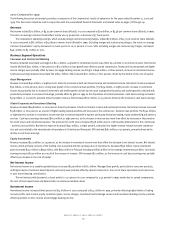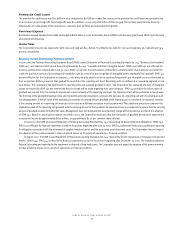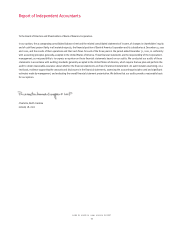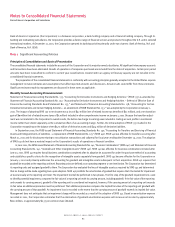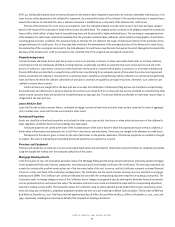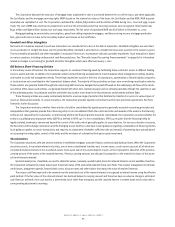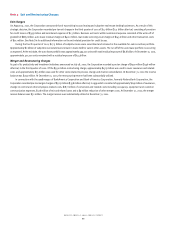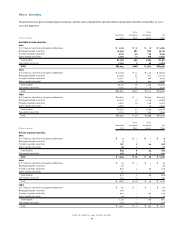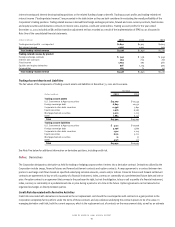Bank of America 2001 Annual Report Download - page 86
Download and view the complete annual report
Please find page 86 of the 2001 Bank of America annual report below. You can navigate through the pages in the report by either clicking on the pages listed below, or by using the keyword search tool below to find specific information within the annual report.
BANK OF AMERICA 2001 ANNUAL REPORT
84
The Corporation occasionally purchases or issues financial instruments containing embedded derivatives. The embedded derivative is separated
from the host contract and carried at fair value if the economic characteristics of the derivative are not clearly and closely related to the economic
characteristics of the host contract. To the extent that the Corporation cannot reliably identify and measure the embedded derivative, the entire contract
is carried at fair value on the balance sheet with changes in fair value reflected in earnings.
The Corporation formally documents at inception all relationships between hedging instruments and hedged items, as well as its risk management
objectives and strategies for undertaking various hedge transactions. Additionally, the Corporation uses regression analysis at the hedge’s inception
and quarterly thereafter to assess whether the derivative used in its hedging transaction is expected to be or has been highly effective in offsetting
changes in the fair value or cash flows of the hedged items. The Corporation discontinues hedge accounting when it is determined that a derivative is
not expected to be or has ceased to be highly effective as a hedge, and then reflects changes in fair value in earnings.
If a derivative instrument in a fair value hedge is terminated or the hedge designation removed, the difference between a hedged item’s then
carrying amount and its face amount is recognized into income over the original hedge period. Similarly, if a derivative instrument in a cash flow hedge
is terminated or the hedge designation removed, related amounts accumulated in other comprehensive income are reclassified into earnings in the
same period during which the hedged item affects income.
Securities
Debt securities are classified based on management’s intention on the date of purchase. Debt securities which management has the intent and ability
to hold to maturity are classified as held-to-maturity and reported at amortized cost. Securities that are bought and held principally for the purpose
of resale in the near term are classified as trading instruments and are stated at fair value with unrealized gains and losses included in trading
account profits. All other debt securities are classified as available-for-sale and carried at fair value with net unrealized gains and losses included in
shareholders’ equity on an after-tax basis.
Interest and dividends on securities, including amortization of premiums and accretion of discounts, are included in interest income. Realized
gains and losses from the sales of securities are determined using the specific identification method.
Marketable equity securities, which are included in other assets, are carried at fair value. Net unrealized gains and losses are included in
shareholders’ equity, net of tax; income is included in noninterest income. Venture capital investments for which there are active market quotes are
carried at estimated fair value, subject to liquidity discounts, sales restrictions or regulatory rules. Net unrealized gains and losses are recorded in non-
interest income. Venture capital investments for which there are not active market quotes are initially valued at cost. Subsequently, these investments
are adjusted to reflect changes in valuation as a result of initial public offerings or other-than-temporary declines in value.
Loans and Leases
Loans are reported at their outstanding principal balances net of any unearned income, charge-offs, unamortized deferred fees and costs on originated
loans and premiums or discounts on purchased loans. Loan origination fees and certain direct origination costs are deferred and recognized as
adjustments to income over the lives of the related loans. Unearned income, discounts and premiums are amortized to income using methods that
approximate the interest method.
The Corporation provides equipment financing to its customers through a variety of lease arrangements. Direct financing leases are carried at
the aggregate of lease payments receivable plus estimated residual value of the leased property, less unearned income. Leveraged leases, which are
a form of financing lease, are carried net of nonrecourse debt. Unearned income on leveraged and direct financing leases is amortized over the lease
terms by methods that approximate the interest method.
Allowance for Credit Losses
The allowance for credit losses is management’s estimate of probable incurred credit losses in the lending portfolios. Additions to the allowance for
credit losses are made by charges to the provision for credit losses. Credit exposures deemed to be uncollectible are charged against the allowance
for credit losses. Recoveries of previously charged off amounts are credited to the allowance for credit losses.
The Corporation performs periodic and systematic detailed reviews of its lending portfolios to identify inherent risks and to assess the overall
collectibility of those portfolios. The allowance on certain homogeneous loan portfolios, which generally consist of consumer loans, is based on
aggregated portfolio segment evaluations generally by loan type. Loss forecast models are utilized for these segments which consider a variety of
factors including, but not limited to, historical loss experience, anticipated defaults or foreclosures based on portfolio trends, delinquencies and
credit scores, and expected loss factors by loan type. The remaining portfolios are reviewed on an individual loan basis. Loans subject to individual
reviews are analyzed and segregated by risk according to the Corporation’s internal risk rating scale. These risk classifications, in conjunction with an
analysis of historical loss experience, current economic conditions and performance trends within specific portfolio segments, and any other
pertinent information (including individual valuations on nonperforming loans in accordance with Statement of Financial Accounting Standards
No. 114, “Accounting by Creditors for Impairment of a Loan” (SFAS 114)) result in the estimation of specific allowances for credit losses.
If necessary, an allowance for credit losses is established for individual impaired loans. A loan is considered impaired when, based on current
information and events, it is probable that the Corporation will be unable to collect all amounts due, including principal and interest, according to the
contractual terms of the agreement. Once a loan has been identified as individually impaired, management measures impairment in accordance with


